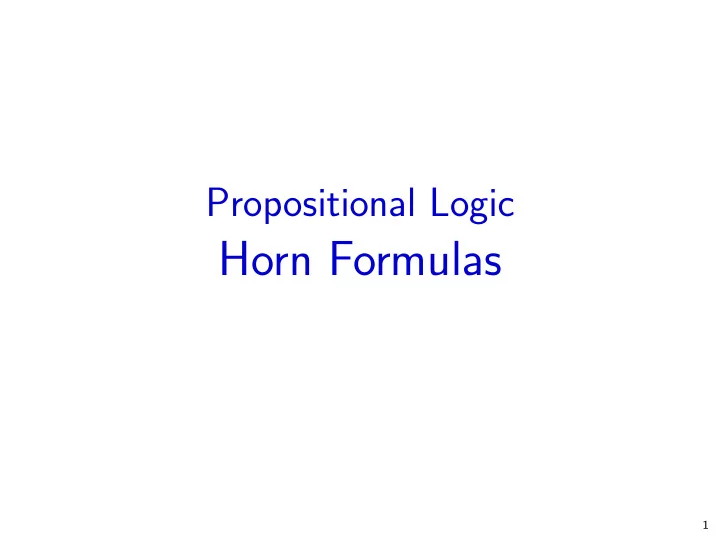

Propositional Logic Horn Formulas 1
Efficient satisfiability checks In the following: ◮ A very efficient satisfiability check for the special class of Horn formulas. ◮ Efficient satisfiability checks for arbitrary formulas in CNF: resolution (later). 2
Horn formulas Definition A formula F in CNF is a Horn formula if every disjunction in F contains at most one positive literal. A disjunction in a Horn formula can equivalently be viewed as an implication K → B where K is a conjunction of atoms or K = ⊤ and B is an atom or B = ⊥ : ( ¬ A ∨ ¬ B ∨ C ) ≡ ( A ∧ B → C ) ( ¬ A ∨ ¬ B ) ≡ ( A ∧ B → ⊥ ) A ≡ ( ⊤ → A ) 3
Satisfiablity check for Horn formulas Input: a Horn formula F . Algorithm building a model (assignment) M : for all atoms A i in F do M ( A i ) := 0; while F has a subformula K → B such that M ( K ) = 1 and M ( B ) = 0 do if B = ⊥ then return “unsatisfiable” else M ( B ) := 1 return “satisfiable” Maximal number of iterations of the while loop: number of implications in F Each iteration requires at most O ( | F | ) steps. Overall complexity: O ( | F | 2 ) [Algorithm can be improved to O ( | F | ). See Sch¨ oning.] 4
Correctness of the model building algorithm Theorem The algorithm returns “satisfiable” iff F is satisfiable. Proof Observe: if the algorithm sets M ( B ) = 1, then A ( B ) = 1 for every assignment A such that A ( F ) = 1. This is an invariant. (a) If “unsatisfiable” then unsatisfiable. We prove unsatisfiability by contradiction. Assume A ( F ) = 1 for some A . Let ( A i 1 ∧ . . . ∧ A i k → ⊥ ) be the subformula causing “unsatisfiable”. Since M ( A i 1 ) = · · · = M ( A i k ) = 1, A ( A i 1 ) = . . . = A ( A i k ) = 1. Then A ( A i 1 ∧ . . . ∧ A i k → ⊥ ) = 0 and so A ( F ) = 0, contradiction. So F has no satisfying assignments. 5
(b) If “satisfiable” then satisfiable. After termination with “satisfiable”, for every subformula K → B of F , M ( K ) = 0 or M ( B ) = 1. Therefore M ( K → B ) = 1 and thus M | = F . In fact, the invariant shows that M is the minimal model of F . 6
Recommend
More recommend